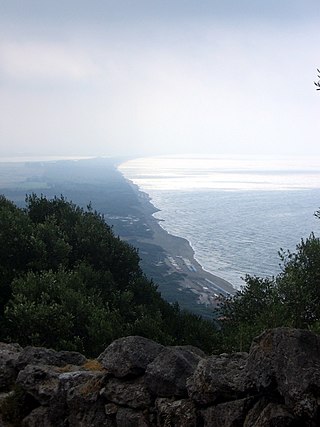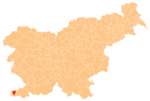
Istria is the largest peninsula within the Adriatic Sea. Located at the top of the Adriatic between the Gulf of Trieste and the Kvarner Gulf, the peninsula is shared by three countries: Croatia, Slovenia, and Italy, 90% of its area being part of Croatia. Most of Croatian Istria is part of Istria County.

Izola is a town in southwestern Slovenia on the Adriatic coast of the Littoral traditional region. It is the seat of the Municipality of Izola and is one of the three major towns of Slovenian Istria.
The area known as Croatia today has been inhabited throughout the prehistoric period, ever since the Stone Age, up to the Migrations Period and the arrival of the White Croats.

The Acta Triumphorum or Triumphalia, better known as the Fasti Triumphales, or Triumphal Fasti, is a calendar of Roman magistrates honoured with a celebratory procession known as a triumphus, or triumph, in recognition of an important military victory, from the earliest period down to 19 BC. Together with the related Fasti Capitolini and other, similar inscriptions found at Rome and elsewhere, they form part of a chronology referred to by various names, including the Fasti Annales or Historici, Fasti Consulares, or Consular Fasti, and frequently just the fasti.

Cosa was an ancient Roman city near the present Ansedonia in southwestern Tuscany, Italy. It is sited on a hill 113 m above sea level and 140 km northwest of Rome on the Tyrrhenian Sea coast. It has assumed a position of prominence in Roman archaeology owing to its excavation.

The Histri or Istri were an ancient people inhabiting the Istrian Peninsula, to which they gave the name Histria. Their territory stretched to the neighbouring Gulf of Trieste and bordered the Iapodes in the hinterland of Tarsatica. The Histri formed a kingdom.

Liburnia in ancient geography was the land of the Liburnians, a region along the northeastern Adriatic coast in Europe, in modern Croatia, whose borders shifted according to the extent of the Liburnian dominance at a given time between 11th and 1st century BC. Domination of the Liburnian thalassocracy in the Adriatic Sea was confirmed by several Antique writers, but the archeologists have defined a region of their material culture more precisely in northern Dalmatia, eastern Istria, and Kvarner.

Gortyn, Gortys or Gortyna is a municipality, and an archaeological site, on the Mediterranean island of Crete 45 km (28 mi) away from the island's capital, Heraklion. The seat of the municipality is the village Agioi Deka. Gortyn was the Roman capital of Creta et Cyrenaica. The area was first inhabited around 7000 BC.

Nesactium was an ancient fortified town and hill fort of the Histri tribe. Its ruins are located in southern Istria, Croatia, between the villages of Muntić and Valtura.

Corinth was a city-state (polis) on the Isthmus of Corinth, the narrow stretch of land that joins the Peloponnese peninsula to the mainland of Greece, roughly halfway between Athens and Sparta. The modern city of Corinth is located approximately 5 kilometres (3.1 mi) northeast of the ancient ruins. Since 1896, systematic archaeological investigations of the Corinth Excavations by the American School of Classical Studies at Athens have revealed large parts of the ancient city, and recent excavations conducted by the Greek Ministry of Culture have brought to light important new facets of antiquity.
Epulon was a king or tribal leader of the Histri in northern Illyria. Epulon conducted a series of wars against commanders sent by the Roman Republic during the Roman expansion of the first half of the 2nd century BC, until his death in 177 BC.
The Marina Izola lies in the Slovenian town of Izola. The marina has berths for about 620 boats with a length of up to 30 m and a depth of 4.5 m. In addition, there is also a holiday resort with a hotel and many different attractions such as tennis courts, swimming pool and casino.

Jagodje is a settlement on the Adriatic coast in the Municipality of Izola in the Littoral region of Slovenia. It is an urbanized settlement directly southwest of the town of Izola and was created from dispersed farmsteads in the area known as Jagodje and the hamlets of Kane (Canne), Kanola (Cànola), Kažanova (Casanova), Kostrlag (Costerlago), Lavore (Lavoré), Liminjan (Limignano), Loret (Loreto), Montekalvo (Montecalvo), and Šalet (Saletto). The local church is dedicated to the Holy Mother of Loreto. An ancient Roman port and settlement known as Haliaetum stood in the area of Simon Bay next to Jagodje as early as the 2nd century BC.

Stabiae was an ancient city situated near the modern town of Castellammare di Stabia and approximately 4.5 km southwest of Pompeii. Like Pompeii, and being only 16 km (9.9 mi) from Mount Vesuvius, it was largely buried by tephra ash in the 79 AD eruption of Mount Vesuvius, in this case at a shallower depth of up to 5 m.

Slovene Istria is a region in southwest Slovenia. It comprises the northern part of the Istrian peninsula, and is part of the wider geographical-historical region known as the Slovene Littoral. Its largest urban center is Koper. Other large settlements are Izola, Piran, and Portorož. The entire region has around 120 settlements. In its coastal area, both Slovene and Italian are official languages.

Hamaxitus was an ancient Greek city in the south-west of the Troad region of Anatolia which was considered to mark the boundary between the Troad and Aeolis. Its surrounding territory was known in Greek as Ἁμαξιτία (Hamaxitia), and included the temple of Apollo Smintheus, the salt pans at Tragasai, and the Satnioeis river. It was probably an Aeolian colony. It has been located on a rise called Beşiktepe near the village of Gülpınar in the Ayvacık district of Çanakkale Province, Turkey.

Aphrodisias, sometimes called Aphrodisias of Cilicia to distinguish it from the town of the same name in Caria, was a port city of ancient Cilicia whose ruins now lie near Cape Tisan in Mersin Province, Turkey.

The Slovene Riviera is the coastline of Slovenia, located on the Gulf of Trieste, by the Adriatic Sea. It is part of the Istrian peninsula and is 46.6 km long. The region comprises the towns of Koper and Piran with Portorož, and the municipality of Izola. It is a seaside tourist destination, with a vibrant multiethnic Slovenian and Italian heritage.

Kilise Tepe is a mound in Mersin Province, Turkey, just west of the Göksu River, lying 20 kilometers from Mut and 145 kilometers from Mersin. It was initially known as Maltepe which is actually the name of a site on the other bank of the river about four kilometers to the west. The original name of the mound is not known and Kilise Tepe in Turkish means "church-hill" referring to a church ruin. The site is thought to have been part of the land of Tarḫuntašša, formed when Muwatalli II moved the Hittite capital.

The Agora of Smyrna, alternatively known as the Agora of İzmir, is an ancient Roman agora located in Smyrna. Originally built by the Greeks in the 4th century BC, the agora was ruined by an earthquake in 178 AD. Roman Emperor Marcus Aurelius ordered its reconstruction. Excavations started in 1933. In 2020, the Agora of Smyrna became a Tentative World Heritage Site as part of "The Historical Port City of Izmir."


















